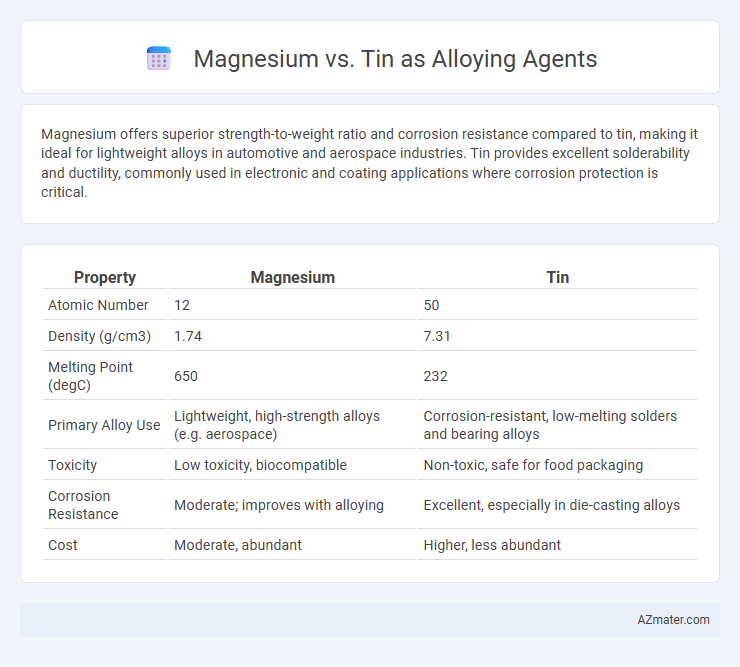Magnesium offers superior strength-to-weight ratio and corrosion resistance compared to tin, making it ideal for lightweight alloys in automotive and aerospace industries. Tin provides excellent solderability and ductility, commonly used in electronic and coating applications where corrosion protection is critical.
Table of Comparison
| Property | Magnesium | Tin |
|---|---|---|
| Atomic Number | 12 | 50 |
| Density (g/cm3) | 1.74 | 7.31 |
| Melting Point (degC) | 650 | 232 |
| Primary Alloy Use | Lightweight, high-strength alloys (e.g. aerospace) | Corrosion-resistant, low-melting solders and bearing alloys |
| Toxicity | Low toxicity, biocompatible | Non-toxic, safe for food packaging |
| Corrosion Resistance | Moderate; improves with alloying | Excellent, especially in die-casting alloys |
| Cost | Moderate, abundant | Higher, less abundant |
Introduction to Alloying Agents: Magnesium vs Tin
Magnesium and tin are key alloying agents used to enhance metal properties, with magnesium primarily improving strength and corrosion resistance in aluminum alloys, while tin is valued for its ability to increase machinability and reduce friction in copper and lead-based alloys. Magnesium's low density and high strength-to-weight ratio make it essential for lightweight aerospace and automotive components, whereas tin's excellent lubricity and soldering capabilities are critical in electronics and tin-based coatings. Understanding the distinct roles of magnesium and tin in alloying helps optimize material performance for specific industrial applications.
Chemical Properties: Magnesium and Tin Compared
Magnesium exhibits high reactivity with oxygen, forming a stable oxide layer that enhances corrosion resistance, while tin is less reactive but provides excellent wetting properties and malleability. Chemically, magnesium has a lower atomic weight (24.3 u) and higher electronegativity (1.31) compared to tin's atomic weight (118.7 u) and electronegativity (1.96), influencing the alloy's strength and ductility. Magnesium alloys typically offer superior strength-to-weight ratios, whereas tin-containing alloys excel in soldering and anti-corrosive applications due to tin's chemical stability and softness.
Alloy Formation Capabilities
Magnesium exhibits superior alloy formation capabilities due to its lightweight nature and excellent strength-to-weight ratio, making it ideal for producing high-performance aerospace and automotive alloys. Tin, while less impactful on mechanical strength, enhances corrosion resistance and machinability in alloys such as bronze and solder metals. The choice between magnesium and tin as an alloying agent largely depends on the desired balance between structural performance and corrosion resistance in the final material.
Mechanical Strength Enhancement
Magnesium enhances mechanical strength in alloys by improving tensile strength and fatigue resistance, especially in aluminum-magnesium alloys used in aerospace and automotive industries. Tin contributes to corrosion resistance but generally provides less mechanical strength enhancement compared to magnesium, making it more suitable for bearing alloys and solder applications. The superior strengthening effect of magnesium stems from its ability to form solid solution and precipitation hardening phases, which refine microstructure and improve load-bearing capacity.
Corrosion Resistance in Magnesium and Tin Alloys
Magnesium alloys exhibit excellent corrosion resistance when alloyed with tin, as tin forms a protective oxide layer that reduces galvanic corrosion and enhances surface stability. Tin additions improve the corrosion behavior of magnesium by refining the microstructure and decreasing the formation of detrimental intermetallic phases. This synergy makes magnesium-tin alloys highly suitable for lightweight applications requiring durability in corrosive environments.
Weight and Density Considerations
Magnesium, with a density of approximately 1.74 g/cm3, is significantly lighter than tin, which has a density of about 7.31 g/cm3, making magnesium a preferred alloying agent for lightweight applications in automotive and aerospace industries. Alloys containing magnesium achieve reduced overall weight and improved fuel efficiency without compromising strength, unlike tin-based alloys that contribute to heavier components. Weight-sensitive designs benefit from magnesium's low density, while tin is typically used for its corrosion resistance and malleability rather than weight reduction.
Cost and Availability of Alloying Agents
Magnesium offers a cost-effective alloying solution due to its abundant availability and low raw material price compared to tin, which is relatively scarce and more expensive. The widespread presence of magnesium in the earth's crust contributes to stable supply chains, whereas tin's limited deposits and geopolitical constraints often lead to price volatility. Manufacturers favor magnesium alloys for large-scale production where cost efficiency and material accessibility are critical factors.
Industrial Applications and Usage
Magnesium and tin serve distinct roles as alloying agents in industrial applications, with magnesium primarily enhancing strength-to-weight ratios in aluminum alloys used in automotive and aerospace sectors. Tin, on the other hand, is valued for its corrosion resistance and lubricity, commonly alloyed with copper in bearing materials and solders. The choice between magnesium and tin depends on desired properties such as weight reduction versus wear resistance in manufacturing components.
Environmental Impact and Sustainability
Magnesium as an alloying agent offers a lower environmental impact due to its abundant availability and recyclability, significantly reducing carbon emissions during production compared to tin. Tin mining and refining involve greater energy consumption and toxic byproducts, raising concerns about soil and water contamination. Sustainable alloy development favors magnesium for its lightweight properties and eco-friendly lifecycle, supporting greener manufacturing processes in industries such as automotive and aerospace.
Choosing the Right Alloying Agent: Magnesium or Tin
Magnesium offers lightweight and high strength properties ideal for aerospace and automotive alloys, enhancing corrosion resistance and improving mechanical performance. Tin, known for its excellent solderability and resistance to oxidation, is commonly used in lead-free solder alloys and coatings. Selecting magnesium over tin depends on the application's demand for strength-to-weight ratio versus surface protection and electrical conductivity.

Infographic: Magnesium vs Tin for Alloying Agent
 azmater.com
azmater.com